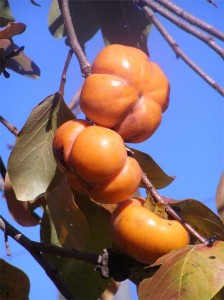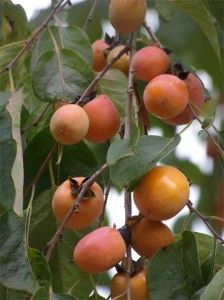Bigger’s not better!

Apple-size fruit of Japanese persimmon are larger but not tastier than native persimmon. Photo by Ken Moore.
By Ken Moore
Several weeks ago, I was quizzed by a Citizen reader about a particularly dramatic small tree in a Carrboro yard along his daily route near the intersection of Hillsborough and North Greensboro streets. He described it as a small tree having orange miniature pumpkin-like fruits. I had to pause and think for a short while. “Oh, yes, I remember there is a small tree in that neighborhood that appears festooned with lots of little jack-o’-lanterns.â€
It’s one of those eye-catching Japanese persimmons, Diospyros kaki, often simply called kaki. It is a small tree that bears orange, fleshy fruit, delicious when eaten fresh or used for jams, breads and puddings.
Though kaki is the most frequently cultivated persimmon species, I don’t think it is as much a delicacy as our native persimmon, Diospyros virginiana, a much taller tree, common in yards and along streets in our local neighborhoods.
The female, fruit-producing trees are easy to find right now by looking for the soft, ripe, quarter-size (sometimes larger), darkened, plum-like fruit on the ground beneath the tree. I began collecting fallen ripe persimmons beneath my favorite tree a month ago, before the recent frosts. Old-timers say it takes several frosts to ripen persimmons. But not any more. Perhaps shorter day light is the trigger. There are lots more on the tree. They’ll be dropping for several weeks more.
The Japanese persimmon in the garden of the nature sanctuary where I sometimes serve as a guide for school groups also has already produced soft ripe fruit.
Note well that you don’t want to taste the fruit of either of these two persimmons if they are hard to the touch. Just accept the “It’ll turn your mouth inside out!†description of anyone who has tasted an unripe one.
Last week, a group of third-graders helped me compare these two persimmons. We tasted a ripe Japanese persimmon growing in the garden and then walked over to a native persimmon growing along the wood’s edge. As tasty as that bigger Japanese variety is, those youngsters, without any prompting from me, showed a preference for the flavor of the native.
Our native has an almost cult-like following. As described in the Nov. 1, 2007 Flora (“Persimmon seasonâ€), folks who treasure persimmons will stake out their favorite tree(s) wherever they are and visit frequently to harvest, hoping other folks don’t know about their secret.
European settlers learned early from Native Americans that this little fruit, sometimes called possum fruit, was good raw or cooked and could be dried for storage. A Native-American word, “pasiminan,†means dried fruit. This fall I’m going to dry a batch to try as dried delicacies.
Medicinally, the persimmon was used extensively. I am particularly intrigued by the description of chewing the bark for heartburn.

Persimmon'07 Though smaller than Japanese persimmon, the flavor of native persimmon has created a cult-like following of admirers. Photo by Ken Moore.
Being a close kin to the tropical ebony tree, the heavy, dark-brown wood of native persimmon has been used for golf clubs, weaver’s shuttles and other items requiring hard, smooth-wearing wood.
Being mindful of how much we have learned from Native Americans, make note of the 14th annual American Indian Heritage Celebration taking place on Saturday, Nov, 21, from 11 a.m. to 4 p.m. at the N.C. Museum of History, across from the N.C. legislature on Jones Street in Raleigh. Dance, food, demonstrations, story-telling and crafts from North Carolina’s Native American tribes are well worth scheduling into your weekend.


Comments are closed.